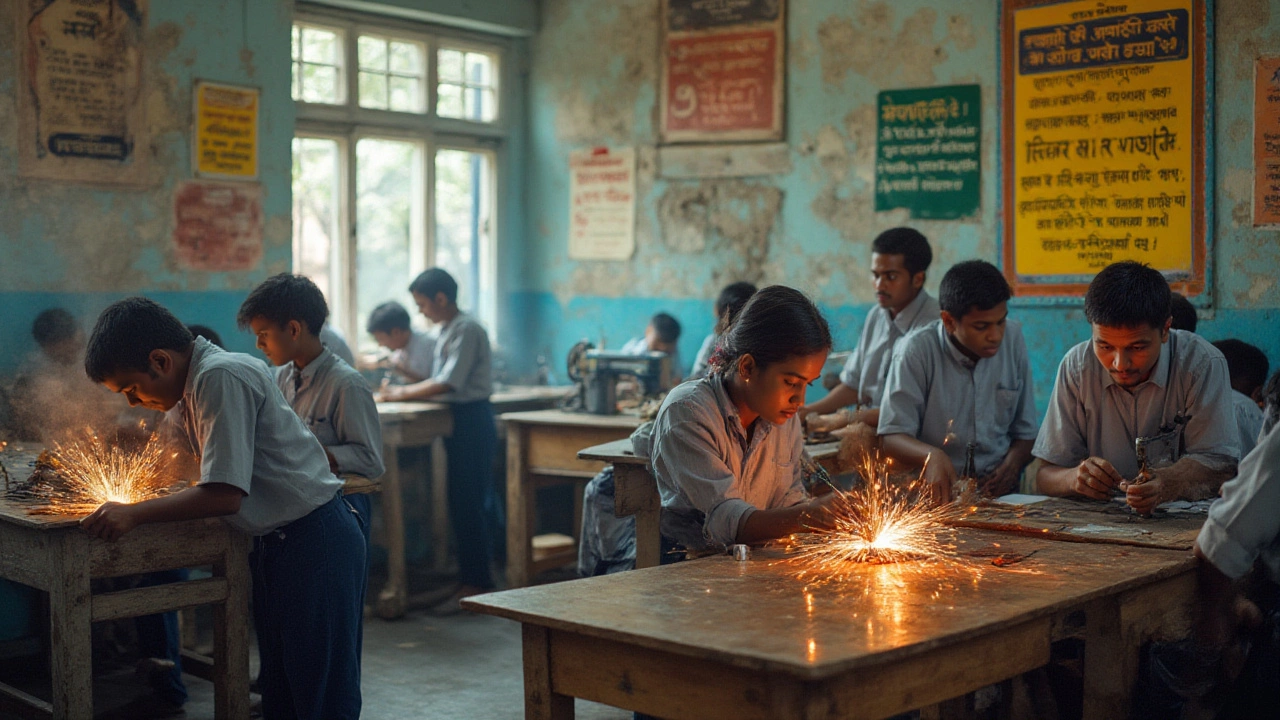Ever notice how everyone talks about 'college,' but hardly anyone mentions vocational school until it’s time to fix your car or wire up your house? There’s this stigma that vocational paths play second fiddle to university degrees, but that’s old thinking. Modern jobs need sharp, skilled hands and focused minds—exactly what you get from vocational training. But here’s the thing: these schools go by a bunch of different names, and most people have no idea what half of them mean. Let’s pull back the curtain on other names for vocational schools and see what they actually offer.
Different Names for Vocational Schools—and Why They Matter
You might hear someone say they went to a 'trade school,' 'career college,' 'technical institute,' or even a 'polytechnic.' These all fall under the big umbrella of vocational education, but each one has its own flavor.
'Trade school' is the term that probably rings a bell for most people. It usually means hands-on jobs—think mechanics, electricians, or welders. If you hear 'technical school' (or 'tech school'), they lean more into technology, electronics, or computer-aided design. 'Career college' sounds a bit fancier and often brings in healthcare training, business support, or culinary arts. 'Polytechnic institutes' blend hands-on training with classroom learning, and in some places like Canada or India, they pack quite a reputation.
This isn’t just wordplay. The name a school picks says a lot about the courses, job tracks, and even the vibe on campus. If a high school grad is looking at 'career academies,' it might mean specialized learning tracks woven right into their regular studies. These differences help you narrow down what fits your goals and learning style. And if you're curious just how wide the pool of names runs, check out this quick table below:
| Alternative Name | Main Focus | Typical Programs | Common Regions |
|---|---|---|---|
| Trade School | Hands-on trades | Electrical, Plumbing, Welding | USA, UK |
| Technical School | Technical training | IT, Drafting, Auto Tech | USA, Australia |
| Career College | Job-specific skills | Healthcare, Legal Assistant, Design | USA, Canada |
| Polytechnic Institute | Combined theory & practice | Engineering Tech, Nursing, Architecture | India, Canada, UK |
| Technical Institute | Technology and applied sciences | Electronics, Robotics, CS | USA, Asia |
| Apprenticeship School | On-the-job learning | Construction, Automotive, Electrician | Germany, Switzerland |
So if you’re scanning school brochures or searching online, don’t just stop at 'vocational school.' Each name unlocks a slightly different world—and it pays to know the difference.
What Sets Vocational and Trade Schools Apart from Traditional Colleges?
The dividing line is all about the end game. Traditional colleges chase broad knowledge, theory, and four-year degrees, with students often bouncing through general education before ever touching a specialty. Vocational schools, on the other hand, zero in on the skills you’ll actually use every day at work. Nothing fancy, just practical, job-ready training.
Programs at trade or technical schools can be much shorter—sometimes just a few months, or up to two years. Grads hit the job market fast. In fact, research by Georgetown University’s Center on Education and the Workforce found that people with a 'career and technical education' (CTE) credential can earn, on average, almost as much as someone with an associate’s degree—sometimes more if they go into high-wage trades like elevator repair or radiation therapy.
And let’s not forget, the cost gap is no joke. A public four-year college in the U.S. can cost over $10,000 a year just in tuition. Trade school? It might run half that for the entire program. That doesn’t even count lost wages from those extra years in class. That 'head start' into the workforce draws plenty of people who want a clear path straight to a pay-check rather than a mountain of student debt.
Flexibility is another calling card for vocational schools. Programs offer part-time, night, or weekend classes, which is a lifesaver for folks juggling work or family. And as technology shifts, many of these institutions pivot fast, adding new programs for things like renewable energy or cybersecurity so nobody gets left behind in the job race.
If you look at countries like Germany, their whole workforce is powered by a deep respect for apprenticeships and technical schools. Young people there often start paid apprenticeships at 16 or 17, learn under mentors, and become certified pros before their university peers even pick a major. The unemployment rate for recent grads is much lower as a result—proof that these schools deliver real value in many places around the world.

What Kinds of Careers Can You Launch From These Schools?
If you think trade or vocational schools only cover plumbers and electricians, you’re missing the bigger picture. The list stretches across dozens of careers—some of which surprise even seasoned professionals.
Healthcare tops the list. Medical assistants, dental hygienists, pharmacy technicians, and radiology techs often train at vocational colleges. Cosmetology and culinary arts? That’s another huge slice of the pie. You’ll also find programs for automotive service techs, HVAC specialists, machinists, and airplane mechanics.
Skilled technology jobs are on fire, too. Schools now offer courses on web development, network administration, and cybersecurity. The explosion in green jobs brought programs for solar installers, wind turbine techs, and energy auditors. Even fields you’d expect to require a university—like graphic design or animation—often start with a technical diploma at a specialty college.
This explosion isn't by accident. U.S. Bureau of Labor Statistics numbers show that jobs like wind turbine technician and solar installer are some of the fastest-growing in the country. The demand for healthcare techs keeps jumping every year as populations age. By 2030, skilled trades may face a shortfall of around 2 million workers just in the United States—someone’s got to replace all those retiring baby boomers, after all.
But the real magic is in the speed and focus. No wasted time on unrelated subjects. You get exactly the knowledge and hands-on training you need to hit the ground running. That’s how grads secure jobs while others are still sitting through lectures in big auditoriums.
Tips for Choosing the Right Vocational School or Program
The best school isn’t always the flashiest one. If you’re picking a vocational or technical program, do some homework (the smart, pain-free kind). Here are a few tips to nail your choice:
- Vocational school accreditation matters. Check if it’s recognized by groups like the Council on Occupational Education (COE) or the Accrediting Commission of Career Schools and Colleges (ACCSC). This helps make sure you’re getting legit, up-to-date training—and employers care about it.
- Ask about placement rates. Good schools brag about how many grads land jobs in their field. If their numbers sound vague, that’s a red flag.
- Visit the campus (or do a virtual tour). Look for clean workshops, modern equipment, and active students. If they’re teaching you to fix cars but use clunky, ancient tools, keep hunting.
- Connect with actual students and recent grads. They can give the real scoop on the teachers, late-night study struggles, and what actually happens after graduation.
- Dive into the curriculum. Make sure classes fit the job you want, and check if there are paid internships or apprenticeships as part of the deal. Nothing beats learning on real projects.
- Compare costs. Some public vocational colleges cost way less than private ones. Just because a program charges more doesn’t mean you’ll earn more later.
- Don't ignore location. Commutes and housing costs can pile up fast, so pick a program you can actually stick with. Some schools even run satellite campuses or partner with local businesses to make things easier.
- Research local job trends. Don’t just take the school’s word for it. Check websites like O*NET, BLS.gov, or local workforce boards to make sure employers are hiring in your chosen field.
Set yourself up for the career you actually want—not just the one someone else thinks is practical. Your choices matter from day one.

Vocational Education in 2025: Trends and The Future of Skills
The image of technical and career schools is changing fast. We’ve got robots flipping burgers, AI checking medical scans, and entire new industries that didn’t even exist 10 years ago. Traditional four-year colleges are great for some paths, but in a world where practical skills often trump theory, vocational education is having a major moment.
Enrollment in trade programs surged after the pandemic, with construction technology, healthcare support, and high-tech manufacturing drawing the most new students. Remote learning options exploded, too. Some programs now let you start classes online before jumping into hands-on work in person—perfect for juggling life and work.
Big companies are jumping in. Tesla’s START program partners with technical colleges to train EV service techs. Amazon, Google, and IBM have launched career certificate programs (no degree required) for cloud computing and IT support, hiring straight out of these pipelines. That’s a big stamp of approval you just didn’t see a decade ago.
Innovation is cranking up, especially in green jobs and cybersecurity. Colleges now add solar labs, smart-home workshops, and ethical hacking challenges to their regular menu. Even old-school trades are going digital—think plumbers troubleshooting with tablets or electricians designing circuits on AR headsets.
Social attitudes are finally shifting, too. Parents and students are realizing that high-paying careers don’t always demand a bachelor’s degree. The data is there: the U.S. Department of Education says that nearly 30% of community college and technical institute grads out-earn people with bachelor’s degrees just a few years into their careers. And with the student debt crisis making headlines, more people are signaling that skills-first education is the way to go.
The bottom line? Call it a career college, trade school, technical institute, or polytechnic—it all points to hands-on, high-impact learning. The names might change, but the mission’s the same: get real skills, fast, and step confidently into jobs the world actually needs.
